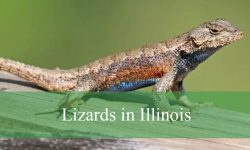Missouri’s diverse landscapes, from bustling cities and river valleys to open fields and woodlands, create excellent habitats for falcons. These raptors are admired for their speed, agility, and sharp eyesight, captivating birdwatchers across the state.
Among the state’s falcon species, the Peregrine Falcon and American Kestrel are the most commonly seen, while Merlins, Gyrfalcons, and Prairie Falcons are rarer visitors. Each species displays unique hunting techniques, behaviors, and habitat preferences, providing fascinating opportunities for observation.
Falcons can be spotted perched on tall buildings, hovering over farmland, or darting through forest edges. Learning to identify their distinguishing features and behaviors enhances every birdwatching experience. This guide highlights all five types of falcons found in Missouri.
Common Falcons Found in Missouri
Peregrine Falcon (Falco peregrinus)
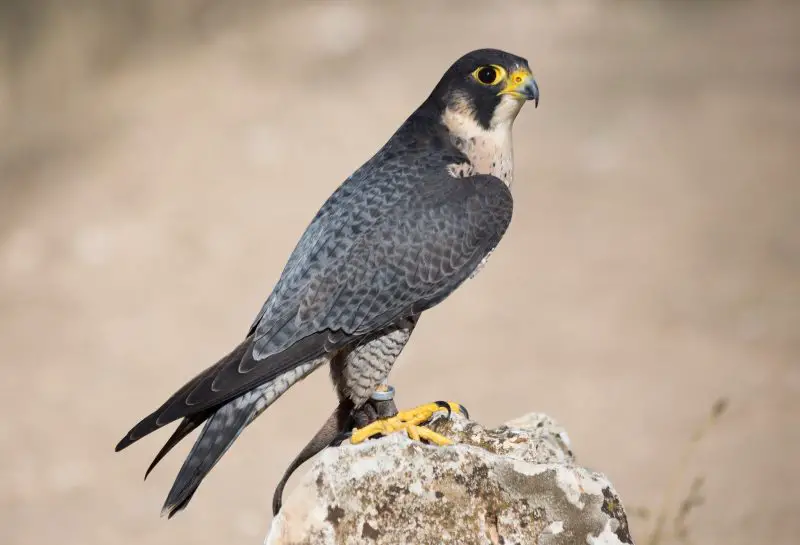
The Peregrine Falcon is celebrated as the fastest animal on Earth, capable of reaching speeds over 200 mph during hunting dives. Adults feature slate-gray to blue-gray upperparts with pale, barred underparts and a bold black “moustache” mark on their faces. Juveniles are brown with streaked underparts and less distinct facial markings, making them slightly more challenging to identify. Their streamlined body and sharply pointed wings allow exceptional agility and precision in flight.
Peregrines are medium-sized raptors, measuring 14–19 inches in length with a wingspan of 39–47 inches. Females are larger than males, sometimes weighing up to 1.5 pounds. Their large eyes provide extraordinary vision, enabling them to spot prey from hundreds of meters. They primarily hunt birds in flight, striking mid-air with powerful talons and a hooked beak designed for gripping and dispatching prey efficiently.
In Missouri, Peregrine Falcons often nest on tall cliffs, river bluffs, or urban structures such as skyscrapers and bridges. Breeding pairs are highly territorial and perform spectacular aerial displays during courtship, including dives and intricate maneuvers. A typical clutch contains 3–4 eggs, with both parents participating in feeding the young, though the female primarily incubates.
Peregrines are visible in Missouri year-round, but breeding activity peaks from March to July. Prime locations include St. Louis, Kansas City, and river valleys along the Missouri and Mississippi Rivers. Observers are likely to see them perched on ledges, swooping over open water, or chasing pigeons and songbirds in urban and natural settings.
American Kestrel (Falco sparverius)
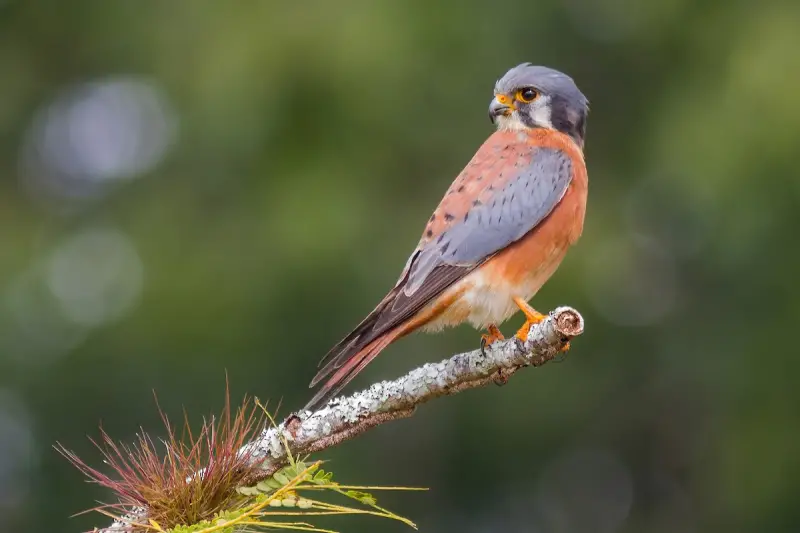
The American Kestrel is North America’s smallest falcon and one of the most colorful. Males display blue-gray wings and a rusty-red back, while females are brown with dark streaking on the wings. Both sexes feature two bold black facial stripes, giving the impression of a masked face. Juveniles resemble adult females but have softer plumage and less distinct markings, making them slightly more subtle in appearance.
Kestrels measure 8–12 inches in length with a wingspan of 20–24 inches and weigh just 3–5 ounces. Despite their small size, they are skilled hunters, often hovering in midair while scanning the ground for insects, small mammals, or tiny birds. Their rapid, precise dives allow them to capture prey effectively in open landscapes.
These falcons are cavity nesters, using tree holes, fence posts, and artificial nest boxes. During the breeding season, males defend hunting territories, while females guard nest sites. A typical clutch consists of 4–5 eggs, with both parents participating in feeding. Kestrels’ adaptability to rural, suburban, and urban habitats makes them widespread throughout Missouri.
American Kestrels are most easily observed from March through September. Open fields, farmland, and roadside utility poles are ideal for spotting them. Their iconic hovering behavior while hunting makes them particularly easy to identify, even from a distance.
Merlin (Falco columbarius)
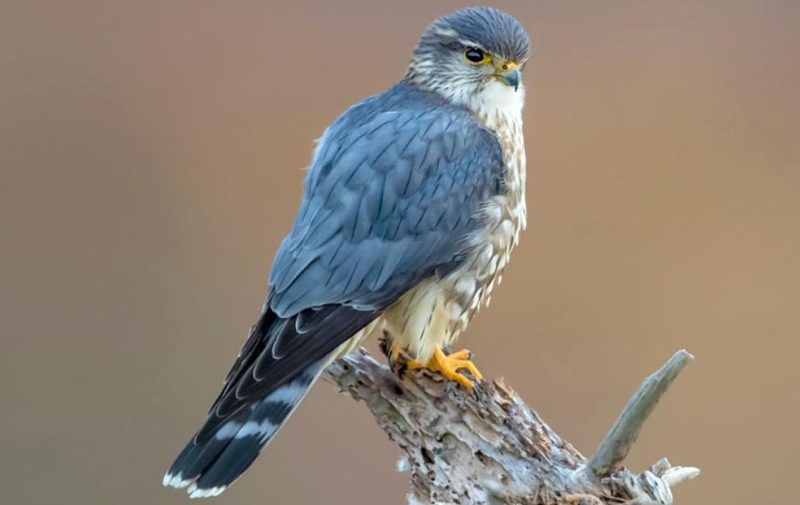
Merlins are small, robust falcons known for their aggressive and fast-paced hunting style. Adult males have slate-gray backs with faintly streaked underparts, while females are brown with heavier streaking. Both sexes show a pale eyebrow stripe above the eye and dark malar marks, which aid in identification. Their compact, muscular build and pointed wings allow rapid, direct flight, perfect for chasing small birds.
Merlins measure 9–13 inches in length with a wingspan of 20–29 inches and weigh 5–7 ounces. Despite their small size, they are fierce predators capable of taking birds twice their size. They employ fast, direct flight with short wingbeats and sudden turns, often attacking from low cover or behind obstacles to surprise their prey. Their diet primarily includes sparrows, finches, and other small songbirds, occasionally supplemented by large insects.
These falcons often nest in abandoned crow or hawk nests located along forest edges or in coniferous stands. Merlins are migratory in Missouri, appearing mostly during fall and winter months. They are highly secretive and can move quickly through forests and open fields in pursuit of prey, making them less conspicuous than Peregrines or Kestrels.
Merlins are best observed in Missouri from October through March, especially in open fields, along forest edges, and near lakes where small birds congregate. Birdwatchers need patience and keen eyesight, as Merlins are fast-moving and often only visible for brief moments during flight.
Gyrfalcon (Falco rusticolus)
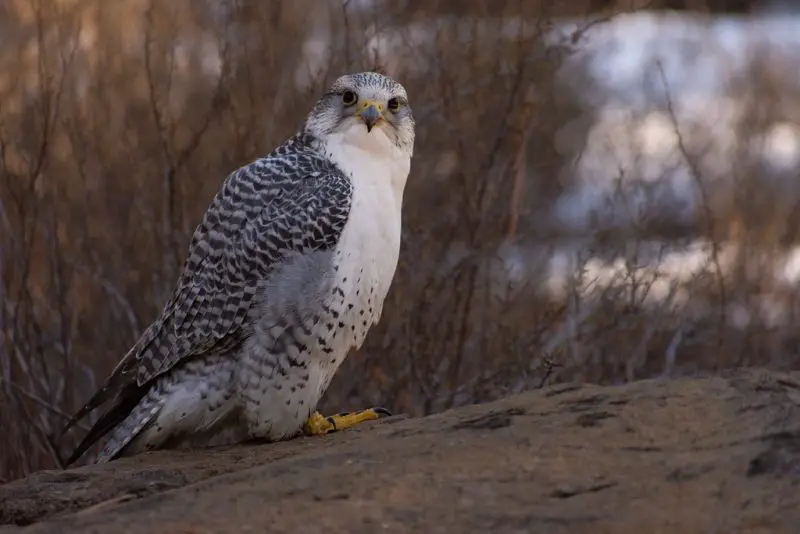
The Gyrfalcon is the largest falcon species in the world, primarily an Arctic bird. Plumage ranges from pure white to dark gray, often heavily barred, providing camouflage in snowy and rocky environments. Juveniles are darker and heavily streaked, while adults develop more uniform coloring. Gyrfalcons are extremely rare in Missouri and are typically seen only as winter visitors during severe weather conditions.
Adult Gyrfalcons measure 20–25 inches long with a wingspan of 48–60 inches. Their powerful, muscular bodies and strong talons allow them to hunt medium-sized birds and mammals. Their flight is direct and forceful, with bursts of rapid wingbeats followed by gliding. Equipped with sharp beaks and talons, they are apex predators capable of overpowering large prey.
These falcons breed in Arctic regions and migrate south in winter. In Missouri, sightings are usually limited to January and February, often in open fields, river valleys, or near lakes where waterfowl are abundant. They are solitary hunters, flying long distances in search of food, and are rarely seen close to human activity.
Because Gyrfalcons are so rare, they are highly prized by birders. Successful sightings require patience and careful observation. Open landscapes and large bodies of water offer the best chances, and even brief glimpses are considered a significant achievement for falcon enthusiasts in Missouri.
Prairie Falcon (Falco mexicanus)
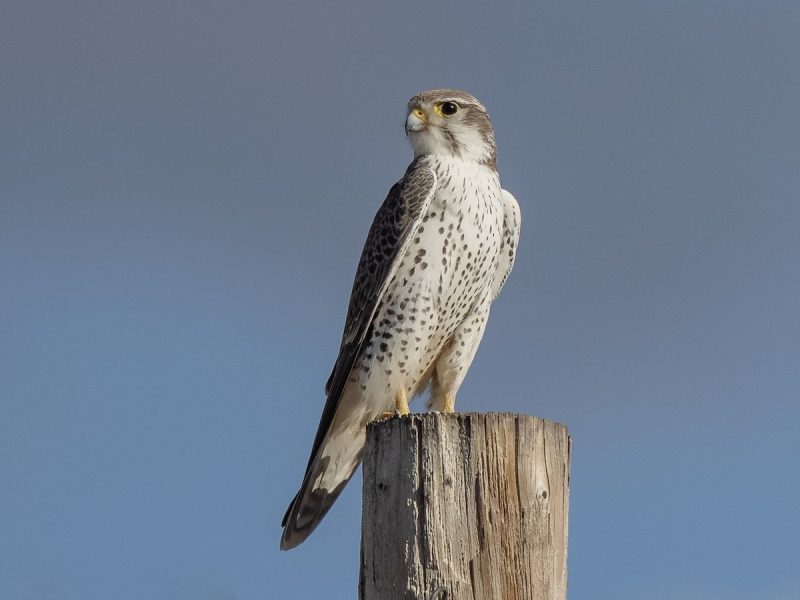
The Prairie Falcon is a medium-sized falcon mostly found in the western U.S., but occasional vagrants have been recorded in Missouri. Its pale brown plumage with darker streaking and a distinct dark malar stripe on the face makes identification possible even at a distance. Adults have long, pointed wings and a narrow tail for speed and maneuverability, while juveniles are darker and heavily streaked.
Prairie Falcons measure 14–20 inches in length with a wingspan of 38–46 inches. They hunt small mammals and birds, using low, fast flight to surprise prey. Their sharp eyesight allows them to detect movement across open landscapes, making them effective hunters even in wide, barren areas.
These falcons nest on cliffs or rocky ledges and are highly territorial during breeding, often engaging in aerial chases to defend their nests. They are adapted to open and semi-arid habitats, but vagrants may occasionally appear in Missouri’s fields, river valleys, or rocky outcrops.
Prairie Falcons are extremely rare in Missouri. Sightings usually occur during migration or harsh winter months. Birders should scan open skies over fields and river valleys, but sightings are brief and unpredictable, making them a prized target for dedicated falcon watchers.
Best Time and Places to See Falcons in Missouri
Falcon sightings in Missouri depend on species and season. Peregrine Falcons are most visible during the breeding season, from March to July, often nesting on tall buildings, bridges, or cliffs along rivers. Prime observation spots include St. Louis, Kansas City, and river valleys along the Missouri and Mississippi Rivers. Early morning and late afternoon are ideal times for seeing them hunting or perched.
American Kestrels are widespread year-round but are easiest to observe from spring through early fall (March–September). They prefer open fields, farmlands, and roadside utility poles. Their characteristic hovering flight while hunting insects or small rodents makes them easy to spot even from a distance.
Merlins appear mostly in fall and winter (October–March). They favor open fields, forest edges, and lakeshores where small songbirds gather. These falcons are fast and secretive, so birdwatchers need patience and a keen eye to spot them.
Gyrfalcons are extremely rare winter visitors, typically seen in January and February. Open fields, river valleys, and lakes with waterfowl provide the best chances for a sighting. Their rarity and unpredictable appearances make them a prized target for birders.
Prairie Falcons, though mostly western birds, occasionally appear in Missouri as vagrants during migration or harsh winters. Open fields, river valleys, and rocky outcrops offer the best opportunities. Sightings are fleeting and require careful scanning of open skies.
FAQs About Falcons in Missouri
Which falcons are most common in Missouri?
The most commonly seen species are Peregrine Falcons and American Kestrels. Merlins appear in winter, while Gyrfalcons and Prairie Falcons are extremely rare vagrants.
What do Missouri falcons eat?
Falcons are primarily bird hunters. Peregrine Falcons feed on pigeons, doves, and songbirds. American Kestrels hunt insects, small mammals, and occasionally tiny birds. Merlins focus on small birds, while Gyrfalcons and Prairie Falcons hunt birds and medium-sized mammals.
Where can I see falcons in urban areas?
Peregrine Falcons often nest on tall buildings and bridges, particularly in St. Louis and Kansas City. American Kestrels may perch on utility poles or hunt over open fields near suburban areas.
When is the best time to watch falcons hunting?
Early morning and late afternoon are ideal. Breeding season increases visibility of Peregrines and Kestrels, while winter months are best for observing Merlins and rare vagrants.
Are falcons endangered in Missouri?
Peregrine Falcons were once endangered due to pesticides but have made a full recovery. American Kestrels have seen population declines in some areas. Other falcon species are generally not considered endangered in Missouri.




